Summary
Fishing imposes agonizing deaths on 1-3 trillion fish per year, as well as many other marine animals. However, (over)fishing has many other indirect effects on wild-animal suffering. This piece surveys reasons why the harvesting of wild fish might reduce as well as increase the suffering of oceanic creatures. The net impact is extremely unclear. Moreover, the sign of net impact may depend on what kind of fish is eaten—for example, catching big piscivorous fish may reduce zooplankton populations, while catching small zooplanktivorous fish may increase zooplankton populations. If you do buy fish, it's plausible though not completely clear that unsustainable kinds are best—e.g., overfished species, those caught with bottom trawling, etc. That said, I would probably err on the side of not eating fish, especially because wild-catch fishing may increase the amount of fish farming in the future.
Note: This piece analyzes commercial marine fishing, especially overfishing. It doesn't focus on recreational fishing, fish farming, or non-fish seafood. I think recreational fishing—especially "catch and release"—is probably bad.
Contents
Introduction
This piece enumerates considerations for evaluating the net impact of fishing on animal suffering. In order to help keep tabs on whether the factors listed in a section are bad or good on balance, I color that section title as red, green, or both, where using both colors indicates an unclear net impact. A greater proportion of red than green letters indicates that I think the net impact is more likely bad than good.
Caveats
Fishing vs. overfishing
This piece focuses on the effects of overfishing on wild-animal suffering. This focus is not unreasonable given that many large predatory fish species are overfished, but whether it holds in any given case depends on the fish species, where the fish was caught, how the fish was caught, and so on. Ray Hilborn believes that claims of overfishing are exaggerated and that many fisheries are actually recovering, especially in Western countries. So it's also important not to assume that any given fish that a person might buy comes from overexploited fisheries.
You can check out "good fish guides" to get more information on whether a fish is overfished. I tentatively guess that in many cases, if you insist on eating fish, it may be better to eat overexploited fish, and if you agree, you might reverse the recommendations of the good-fish guides.
Note that Daniel Pauly expresses skepticism about the reliability of "good fish guides":
The other market-based initiative, prevalent in the United States, distributes wallet-size cards designed to steer consumers toward fish that the group issuing the cards deems to have been caught sustainably. [...] the multitude of such cards leads to contradictions and confusion, as the same fish are assessed differently by different organizations. For example, ahi tuna is rated as “safe,” “questionable,” and “avoid” on the wallet cards issued by three U.S. nonprofits.
Moreover, "more than one-third of all fish are mislabeled" in the US, which adds noise to the use of good-fish guides. That said, if mislabeling tends more often to disguise unsustainable seafood as sustainable than the reverse, then if you prefer unsustainable fish, mislabeling would be less of a problem.
Fortunately, many of the points in this piece apply both to overfishing and sustainable fishing, but some—especially those concerning large-scale ecosystem shifts—may apply mostly to overfishing.
Effects depend on the trophic level of the fish
This piece discusses impacts of fishing on lower trophic levels of the marine food web. The sign of these effects may depend on the trophic level from which the wild fish are caught. For example, catching large predator fish like tuna or salmon may increase forage-fish populations, which then reduces zooplankton populations. On the other hand, catching small sardines or anchovies may increase zooplankton populations.
The specific impacts of fishing will also, of course, depend on the exact species of fish, where the fish is harvested, and so on. This piece aims to offer some general analysis, which may sometimes contradict the situation for a particular case.
Marine vs. freshwater
This piece focuses on marine rather than freshwater ecosystems.
Non-fish species
This piece focuses on catching fish, not crustaceans, oysters, or other seafood. Some of the considerations discussed here would translate to non-fish species, but some would not.
Recreational fishing
The discussion in this piece focuses on commercial fishing. Recreational fishing in ponds and lakes that are stocked with fish seems less likely to have good side effects, in part because the ecological impacts of fishing may be offset by restocking? In that case, the effects of reducing the caught fish species would be somewhat offset, since fish of that species would be added back. Hence, the net effect of fishing would be more just to cause pain to the caught fish (and the bait worms). Here I'm assuming that expected restocking is roughly equal to fishing pressure in the lake; this might be roughly true, since restocking needs to increase the more fish people catch.
Catch-and-release fishing is clearly terrible, because unless the released fish is sufficiently injured or shocked that it dies, the only effect is to hurt and traumatize a fish (not to mention the worm or minnow on the hook), without any other ecological effects. (That said, mortality rates with catch-and-release can be nontrivial.) It's good that catch-and-release has been banned in Switzerland.
This article explains catch-and-release well:
Spokespeople for fishing began talking of catch-and-release. This, they assured, would secure both the future of our victims, and the tradition of humans harassing and killing them. In catch-and-release, we would hook our prey, allow them to suffer as they fought for their lives, and then release them, hoping they would survive to endure this torture again.
Impacts on the animals caught
Pain of being killed
Fishing is extremely painful for the fish and other animals that get caught. There's no requirement for humane slaughter of fish. Most die of asphyxiation in nets or on board ships. Some fish suffer organ damage from being pulled up to the surface. Sharks may be killed for their fins only and then are left to sink in the ocean, where they suffocate or get eaten alive.
Singer and Dawn (2016): "when a fish spends three days on a hook attached to the mile long line of a fishing vessel, that fish is probably spending three days in agony — and that’s before the fish is hauled onto a deck to die slowly of suffocation."
Avoiding natural deaths
Most human-caught wild fish die from asphyxiation and some from physical injury. These deaths seem generally not worse than dying naturally, especially from predation. Here are some videos of fish being eaten by predators:
- "Sharks eating a fish": The prey fish takes several minutes to be torn apart.
- "14" Armatus vampire fish eats 8"trout": The fish takes about a minute to be swallowed and probably several more to begin being digested.
- "Fish eats Fish!! Piranha disgusting": A goldfish is torn apart piece by piece starting from the tail and ending with the head over the course of ~1.5 minutes.
- "Pet Bass eats 8 large commet gold fish": Fortunately, the bass swallows the prey instantaneously, but they clearly don't die right after being swallowed—e.g., one of them escapes the bass's mouth a few seconds after being swallowed. The process of being crushed and digested in the esophagus/stomach of a bigger fish is probably very painful.
Suffering of bait
Recreational and (a small amount of?) commercial fishing causes additional harm to bait—often skewered worms that squirm for several minutes until they drown in the water or get eaten. Sometimes little fish are also used as bait:
The suckers were hooked just under and to the rear of the dorsal fin, in a way that would allow as much movement as possible, and would maximize their survival time. Some fishers would run the hook through their eyes.
See "Live bait" for more horrific examples.
Lower populations of the targeted species
A maximum sustainable yield of fish tends to keep the fish population at about 30% of what the population would be without fishing. Hence, even sustainable fishing can significantly reduce population sizes of the target species, and in general, a lower population size implies less total suffering. Moreover, overfishing may reduce total long-term catches of fish from a given species.
More deaths per unit time?
Prima facie, it seems good that fishing reduces fish numbers, because in general, a lower population size means fewer painful deaths and hence less suffering. On the other hand, does catching fish before they would have naturally died increase the number of deaths per unit time?
Fishing might also favor more r-selected reproduction strategies: "smaller, faster-growing" fish with shorter lifespans. One page notes:
With the disappearance of the majority of the ocean’s main predators and the loss of their habitat, not only are we changing the relative balance of the ocean but also altering the evolutionary process of its species, forcing cycles of premature reproduction and contributing to the decrease in size of the individual fish.
Fish may evolve to become smaller because the larger ones get caught in the nets. This study notes:
The decrease in population size through fishing mortality [...] can also bias the selective advantage of alternative life histories, for example favoring ‘jack’ or early maturing precocial males at the expense of later maturing ‘hooknose’ males (Gross 1996).
Bycatch
A nontrivial portion of harvested marine life is bycatch. This famously includes whales, dolphins, and turtles, but in terms of numbers of animals harmed, bycatch of other fish, crustaceans, etc. is probably much more significant [citation needed].
Discarded marine life accounted for "one-third of the total weight landed annually" in the North Sea. Relative to the ~80 million metric tons of wild-caught fish per year, bycatch amounts to between 7 and 38 million metric tons. 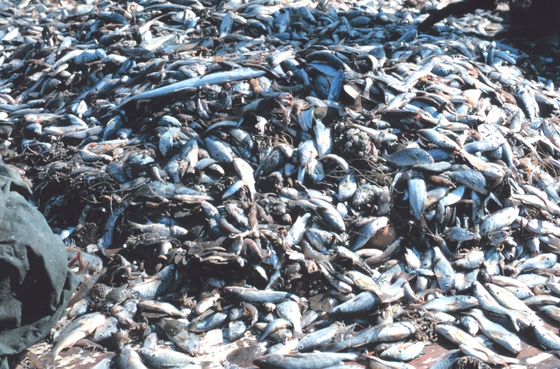 Shrimp trawling has extremely high rates of bycatch (with typical discard rates of ~85%).
Shrimp trawling has extremely high rates of bycatch (with typical discard rates of ~85%).
The net impact of bycatch is itself an enormously complicated question, but since the considerations it raises should tend to mirror the considerations for harvesting target fish species, I'll assume that bycatch mainly multiplies whatever net impact fishing itself has. Of course, it would be good to explore the bycatch issue further.
Ghost nets can be evaluated in a similar way as discarded bycatch, because both have the effect of killing non-target marine animals without providing food for humans.
Blast fishing and cyanide fishing also incur lots of collateral damage, but these practices are probably uncommon ways to kill fish consumed by Westerners. Blast fishing can also destroy coral reefs, which might be good.
Impacts on the marine food chain
More small fish?
Harvesting predatory fish tends, in the short run, to increase populations of smaller fish. According to one study from 2011 led by Dr. Villy Christensen, predatory fish have declined by 2/3 in the last 120 years, while the number of small fish has more than doubled.
While an increase in small fish seems bad prima facie, we also have to consider whether more small fish means fewer fast-growing, short-lived zooplankton or other marine animals?
Finally, as larger fish decline, people may increasingly try to catch smaller fish, including as feed for farmed fish. In such a case, populations of smaller fish could decline rather than increase. That might increase populations of prey the next level down.
Trophic cascades
Fishing can have complicated ripple effects on populations of marine animals at various trophic levels. This piece reviews some scenarios in more detail. It's unclear whether the trophic-cascade effects of fishing seem net good or net bad, and the answer may depend on the specific situation under consideration.
Shorter trophic chains
Assuming we don't care as much about bacteria per kilogram of biomass as about bigger organisms, then we'll tend to favor shorter trophic chains between primary productivity and bacterial composition, because a shorter chain generally involves fewer instances of painful predation. Insofar as fishing cuts off some steps from the ends of trophic chains, we should expect in general that fishing might reduce some suffering from predation.a
This effect seems especially pronounced when overfishing multiplies jellyfish:
Voracious jellyfish predation impacts food webs by converting large quantities of carbon (C), fixed by primary producers and consumed by secondary producers, into gelatinous biomass, which restricts C transfer to higher trophic levels because jellyfish are not readily consumed by other predators. In addition, jellyfish release colloidal and dissolved organic matter (jelly-DOM) [...]. When jelly-DOM was consumed it was shunted toward bacterial respiration rather than production, significantly reducing bacterial growth efficiencies by 10% to 15%. [...] Our findings suggest major shifts in microbial structure and function associated with jellyfish blooms, and a large detour of C toward bacterial CO2 production and away from higher trophic levels.
Another source reports that: "Jellyfish themselves are in a sense a trophic dead end. Energy and organic matter that could otherwise be channelled into harvestable organisms is turned into non-utilisable jelly."
This piece explains:
Synergistic effects of habitat destruction, overfishing, introduced species, warming, acidification, toxins, and massive runoff of nutrients are transforming once complex ecosystems like coral reefs and kelp forests into monotonous level bottoms, transforming clear and productive coastal seas into anoxic dead zones, and transforming complex food webs topped by big animals into simplified, microbially dominated ecosystems with boom and bust cycles of toxic dinoflagellate blooms, jellyfish, and disease. [...] We can only guess at the kinds of organisms that will benefit from this mayhem that is radically altering the selective seascape far beyond the consequences of fishing or warming alone. The prospects are especially bleak for animals and plants compared with metabolically flexible microbes and algae.
Overall impact on fish abundance
WWF's "Living Blue Planet Report 2015" shows the following trend for an index of "1,234 mammal, bird, reptile and fish species":
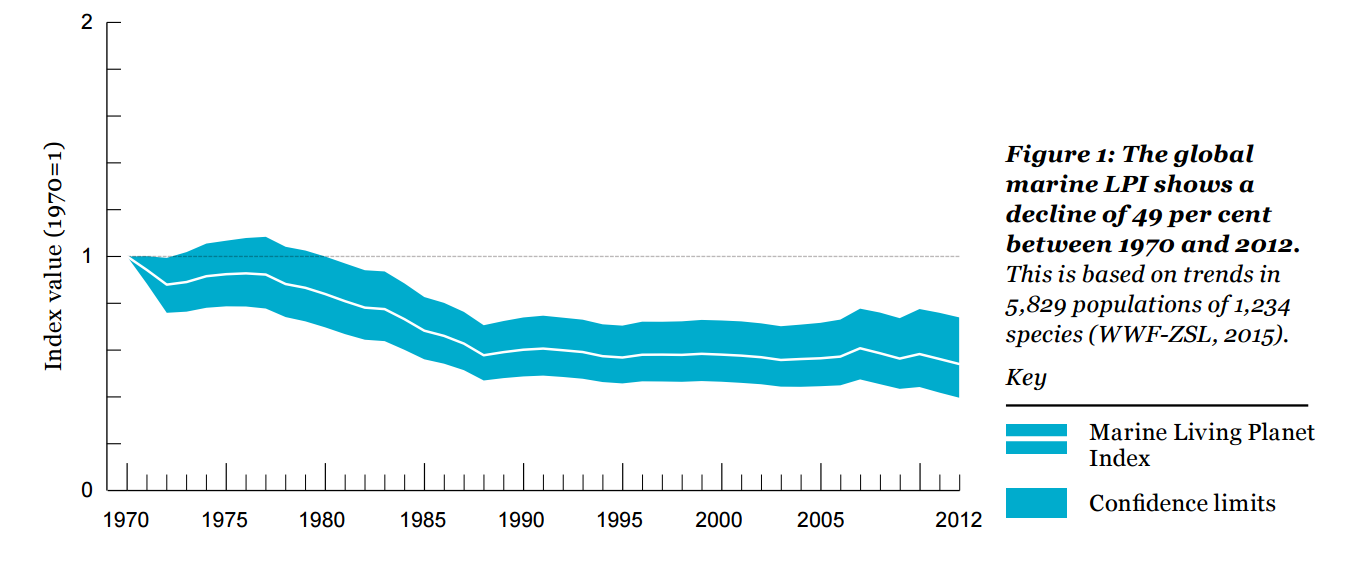
The average decline from 1970 to 2012 was 49%. However, I don't know if this index is biased toward bigger fish species? And it doesn't count marine invertebrates, whose populations could have increased due to less fishing? The same publication does show that krill populations have declined somewhat:
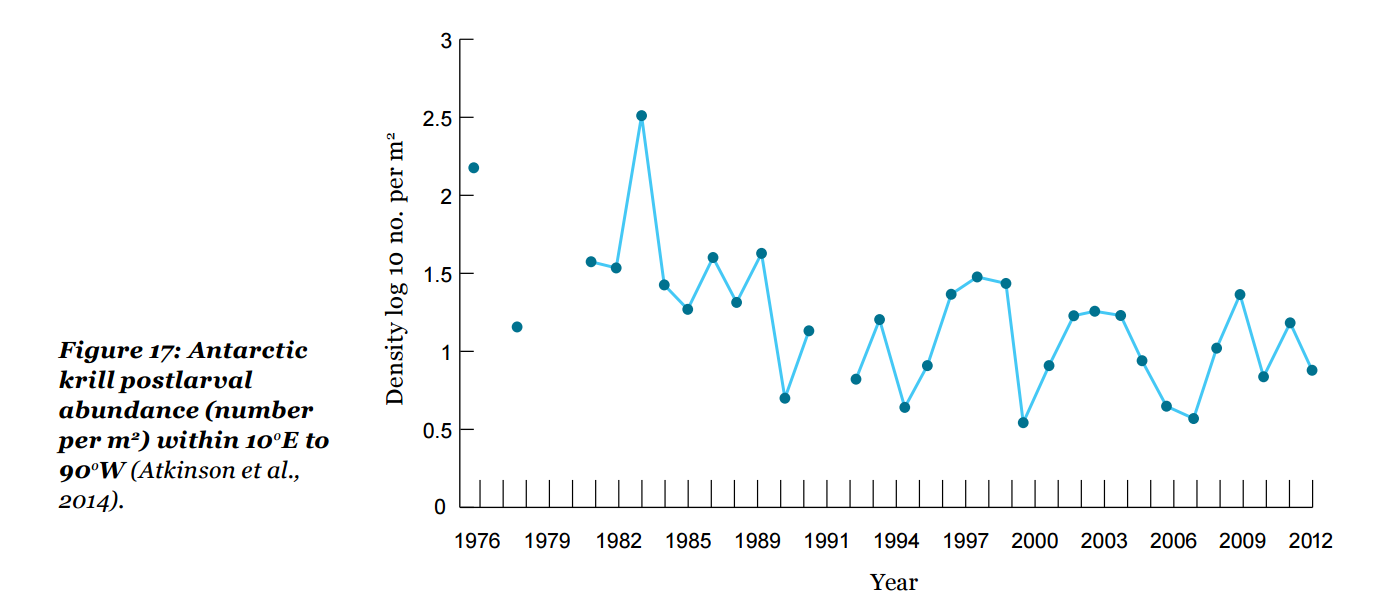
But as the report explains (pp. 20-21), the decline in krill is partly due to climate change, not just to krill fishing. In general, these trends don't distinguish between the effects of fishing vs. the effects of climate change, pollution, eutrophication, etc.
Other ecological impacts
Bottom trawling
Some fish are harvested using bottom trawling. This practice can destroy coral and disrupt shelter for marine organisms; in the long run, this probably reduces their populations? Bottom trawling can also reduce kelp growth by stirring up sediment that blocks light, and it can contribute to anoxic dead zones.
Pauly explains that trawling degrades plant and animal life on the ocean bottom, turning rich marine ecosystems into more barren ones. This seems likely to reduce long-term suffering? (Or do "barren" ecosystems just have larger numbers of smaller animals??) Of course, in the short run, bottom trawling causes immense suffering to the animals that are caught in the trawl's nets, as well as those injured or left homeless/foodless by its path of destruction.
Kelp forest loss
According to a summary of this paper, elimination of otters, cod, etc. has allowed urchins to flourish, and they then decimate kelp forests.
This study reports "that fishing, by removing large predatory lobsters, has reduced the resilience of kelp beds against the climate-driven threat of the sea urchin and thus increased risk of catastrophic shift to widespread sea urchin barrens."
These effects seem positive if urchin barrens support fewer total animals than kelp forests. This study characterizes urchin barrens as "impoverished and unproductive", and another study says urchin barrens have "low primary productivity and low food-web complexity relative to kelp communities and are generally considered a collapsed state of the kelp ecosystem." That said, this article notes that "Despite their name, urchin barrens are usually abundant with marine invertebrate life, echinoderms in particular.[7]" Still, without having been able to find specific data, my guess is that urchin barrens have less total animal biomass, in which case transitions to this state are probably good.
Coral reef loss
This article reports:
Due to local pressures such as overfishing and excessive coastal pollution, coral cover in the Caribbean has declined by more than 50 percent since the 1970s, according to a comprehensive study [...]
The report challenges conventional wisdom about the relative importance of global climate change versus local impacts as the primary driver of coral reef degradation to date. It finds that while climate change poses a threat to corals, local stressors—particularly ones that threaten crucial algae-eating species—have been the main determinant of coral health in the Caribbean to date.
Given that "Coral reefs form some of the world's most productive ecosystems", it seems likely that diminishing coral reefs reduces animal populations.
More jellyfish
Many studies report that overfishing increases jellyfish populations. Even if the jellyfish have comparable biomass as the critters they replace, we might favor this outcome if we think jellyfish are less sentient. Jellyfish do react to stimuli, and some even have eyes, but they're probably less intelligent than other zooplankton predators. Plus, they're 95% water by mass, which is a higher percentage than for most other animals.
One study found that small pelagic fishes in northern Benguela had been mostly replaced by jellyfishes and bearded or pelagic goby (p. 251). Two of the common jellyfish were Aequorea forskalea and Chrysaora fulgida (p. 252).
Another study found an increase in comb jellies Mnemiopsis leidyi due to declines in planktivorous fish:
M. leidyi has been recorded in the Black Sea since 1982 (35), but its population expanded in 1990 when decreased zooplanktivory by overfished stocks created a favorable trophic condition of surplus zooplankton productivity to be used by the burgeoning M. leidyi population (36). The ctenophores are particularly efficient consumers when food density is high (37). Therefore, the M. leidyi bloom seems to have been triggered by a fish stock collapse [...].
Warty comb jellies can decrease fish populations by eating their eggs and young. They also decreased zooplankton by 75% in the Caspian Sea. Assuming these jellies are less sentient than the animals they displace, these effects seem plausibly net good.
Eutrophication
The Wikipedia article on "fishing down the food web" says that the final stage of the ecological consequences from overfishing may be eutrophication in which the ocean becomes a dead zone, decomposition being done by bacteria.
This study (p. 58) reported that fishing led, via a trophic cascade, to increased phytoplankton, which reduced dissolved oxygen:
The frequent phytoplankton blooms and the bulk of unutilized algal biomass produced a shift in the water quality to a state characterized by low transparency and high production of detritus, causing oxygen depletion and hypoxia near the bottom.
How does eutrophication affect zooplankton populations? This page says zooplankton have "doubtful usefulness [...] as an indicator of eutrophication", suggesting that there may not be dramatic correlations between eutrophication and zooplankton population size? One study (in fresh water, not a marine environment) found that "Despite the general statement made by Attayde & Bozelli (1998), that diversity indexes were poor predictors of eutrophication, like us, they found that total zooplankton density increased with eutrophication level" (p. 4, emphasis added).
Black Sea fishing and eutrophication
This study found that, in a simulation, eutrophication caused by excessive nutrients amplified but didn't change the direction of impacts due to fishing in the Black Sea:
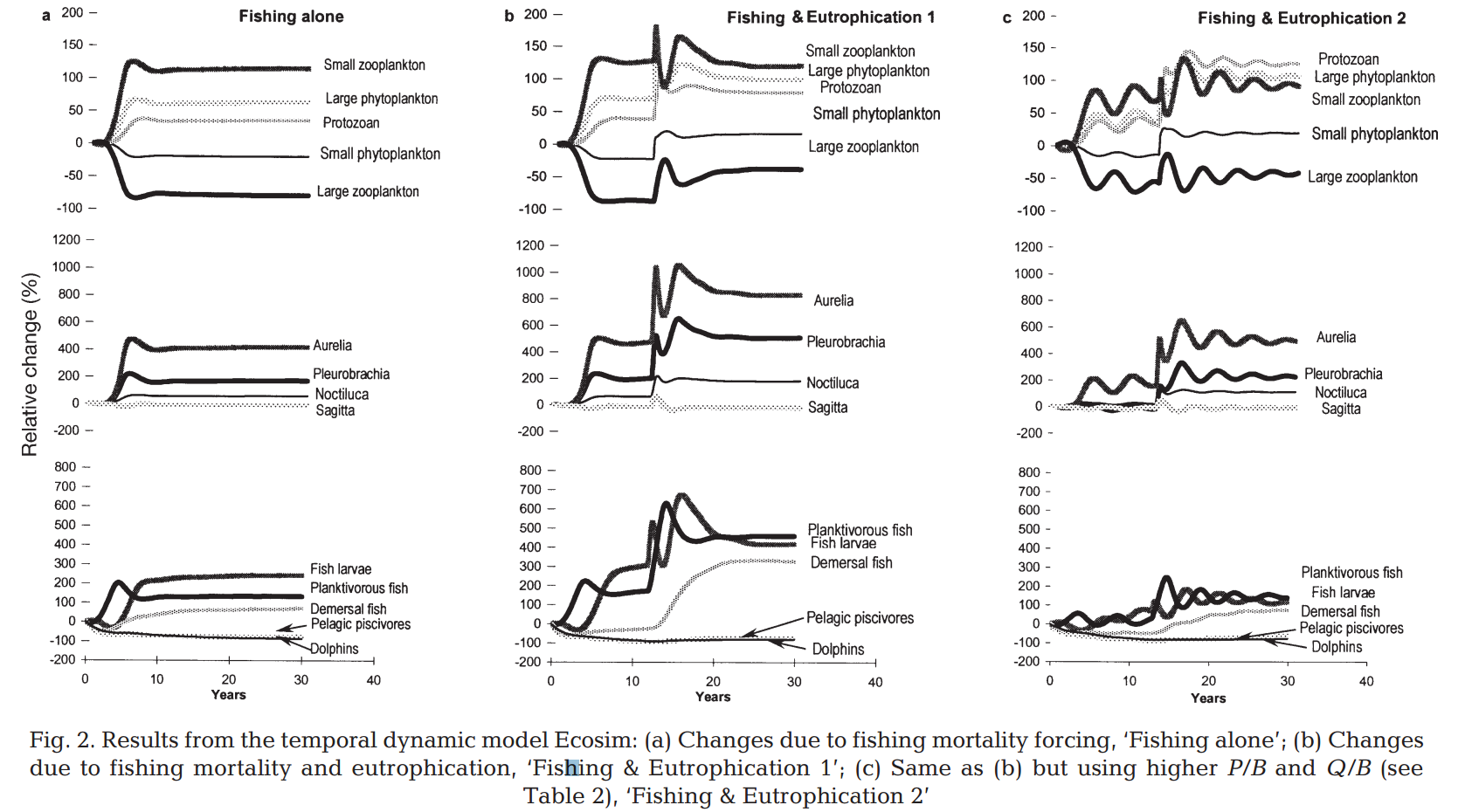
Some zooplankton increased, while others decreased.
And those simulation results matched actual observations reasonably well:
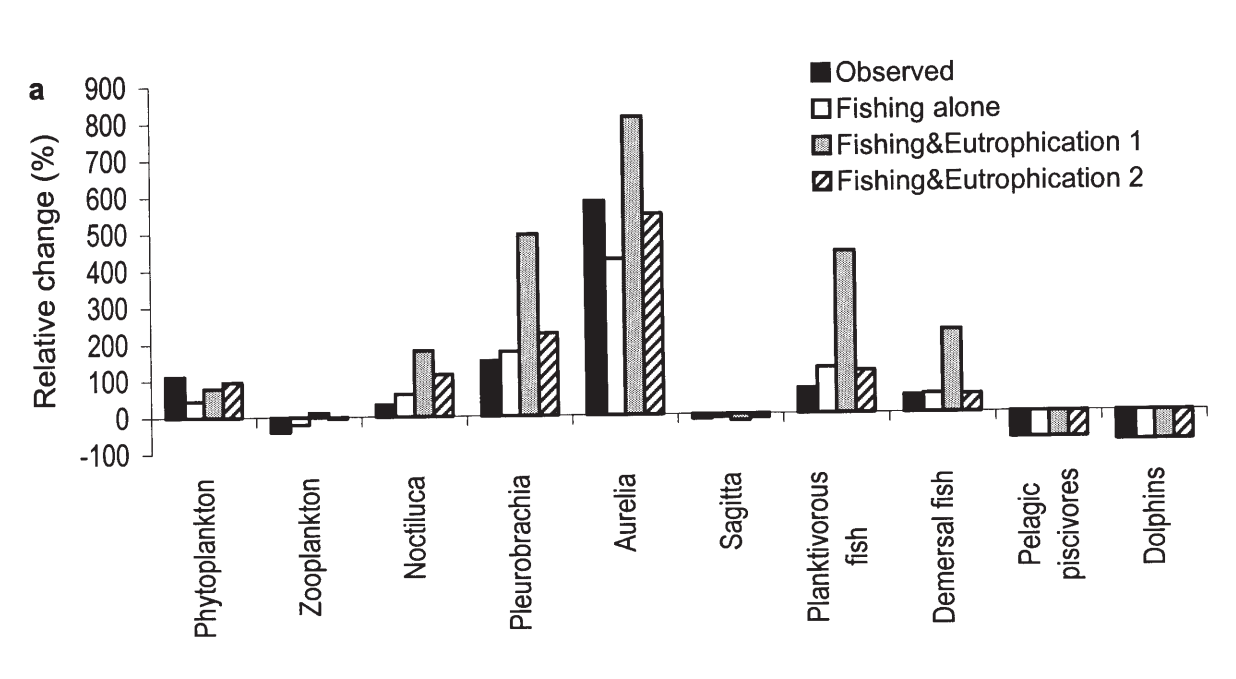
Baltic Sea
This piece says (p. 14) that many areas of the Baltic Sea have low oxygen and some are anoxic. Benthic invertebrates can't live in permanently anoxic conditions, and areas with reduced oxygen have smaller animal populations.
Gelatinous vs. crustacean zooplankton
Jellyfish may displace crustacean zooplankton:
Eutrophication is believed to cause an increase in the relative importance of gelatinous zooplankton vs. crustacean zooplankton. [...] In Kertinge Nor it has been shown that high abundance of jellyfish reduces the importance of zooplankton as grazers on phytoplankton to almost negligible levels (Petersen et al. 1999). Moreover, jellyfish are suspected to affect the recruitment of fish negatively, both by grazing on fish eggs and larvae and by affecting the feeding conditions for fish larvae and planktivorous fish by causing a decrease in the abundance of prey organisms such as copepods.
Since jellyfish are probably less sentient than crustacean zooplankton gram for gram, and since jellyfish support fewer higher trophic levels, their increase seems plausibly good overall.
Comparison with eutrophication due to livestock
Note that wild fish probably causes less eutrophication per gram of protein than farm animals do. So if people eat more fish rather than other meat, fishing probably reduces eutrophication in general, which would reverse the sign of the net impact of the factors discussed in previous paragraphs.
Nitrogen loss and reduced biomass recycling
Fish bodies contain nitrogen, and removing fish from oceans takes that nitrogen out:
only continual input of new nitrogen can determine the total capacity of the ocean to produce a sustainable fish harvest.[20] Harvesting fish from regenerated nitrogen areas will lead to a decrease in nitrogen and therefore a decrease in primary production. [...] However, if fish are harvested from areas of new nitrogen the nitrogen will be replenished.
Reducing primary production is a good side effect. That said, I'm not sure how common it is for primary production to decrease due to fishing.
According to this article: "The open ocean is relatively unproductive because of a lack of nutrients, yet because it is so vast, in total it produces the most primary productivity. Much of the aphotic zone's energy is supplied by the open ocean in the form of detritus."
This paper (p. 29) discusses a simulation of a fish ecosystem in which some portion of input biomass is "recycled" from dead fish becoming detritus. When fishing pressure increases, fewer dead fish contribute to marine detritus, which reduces the biomass of future generations of fish. However, this mainly only happens in "bottom-up control" ecosystems, because in "top-down control" ecosystems, total fish biomass (and hence total future detritus) doesn't decrease as much when top predators are fished, since removing top predators releases prey fish from predation pressure.
In addition, we should also consider the increases in nitrogen and detrital biomass that occur elsewhere after the harvested fish are eaten. The waste might end up as feces of humans, farmed fish, pigs, or chickens, or it might end up in the garbage as uneaten fish. In principle this recycled organic matter could increase productivity of land ecosystems, which would be bad. Fortunately, in some cases, this organic matter causes eutrophication and hence plausibly a decline in animal productivity (especially at anoxic lower depths), which would be good (though eutrophication also causes an increase in bacterial productivity, which is bad).
Fish farming
As wild stocks of fish dwindle, prices rise, causing more consumers to switch to farmed fish. Fish farming is sometimes touted as a solution to declining wild-fish populations. Thus, the net impact of wild-caught fishing is pulled somewhat in the same direction as the net impact of fish farming. The effects of fish farming on wild-animal suffering are themselves multifarious and deserve their own essay, but following are a few considerations.
Probably good:
- Replacement of wild ecosystems.
- Farmed fish may be fed some degree of plant proteins rather than needing to be fed smaller fish.
Probably bad:
- Killing of the fish being raised.
- Overcrowding, stress, and sea lice.
- In the future, insects might be an increasingly popular fish food. Growing insects significantly increases total animal suffering.
Unclear:
- Fish feces might cause eutrophication.
- Pesticides and biocides can leak into the environment and affect wild organisms.
- Crop cultivation is required to produce some fraction of the fish feed.
- Fish farming can sometimes increase farming of wild fish because big predatorial farmed fish are often fed larger amounts of smaller fish.
Does aquaculture use more wild fish than it produces?
Fish farming as a whole doesn't consume more fish than it produces: "Globally, aquaculture uses about half a metric ton of wild whole fish to produce one metric ton of farmed seafood". However, some predatory farmed fish require many times more mass of wild-fish input than the mass of fish output:
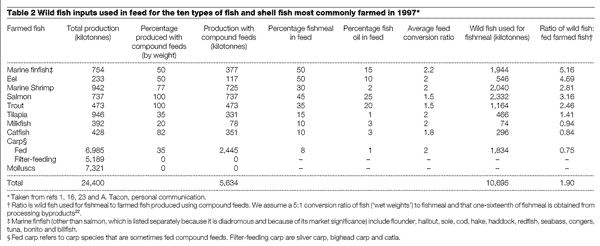
Other considerations
Energy use by fishing boats
Fishing has generally similar energy efficiency as other forms of meat production (see here, Table 12, p. 33). This suggests that it may not increase fossil-fuel use for people to switch from other meats to fish in general (although for any particular species, the direction of the effect would be more clear). Some fish have extremely low energy requirements to harvest, while others have very high requirements.
Energy efficiency per unit fish harvested has consistently and sometimes dramatically declined over time, probably because of reduced fish densities in the water and more powerful boats. Thus, overfishing reduces the energy efficiency of the fishing process.
A main effect of increased energy consumption is climate change, which has both good and bad impacts on wild-animal suffering.
Displacing consumption of land farm animals
Increased consumption of fish in the general population probably causes some reduction in consumption of other forms of meat. Whether this is good or bad depends on the sign of net impact for meat consumption, which is itself a tricky issue. If the amount of substitution away from meat toward fish were nontrivial, this consideration could be pretty important.
Effects on humans
Like with climate change and other anthropogenic environmental impacts, the human costs of overfishing fall primarily on the global poor. According to a UN press release: "Fishing is central to the livelihood and food security of 200 million people, especially in the developing world, while one of five people on this planet depends on fish as the primary source of protein."
In addition to hurting poor people directly, the loss of fish food might also slightly reduce human populations and economic growth, which have their own set of positive and negative effects.
Commercial fishing is the most dangerous job in the US, killing dozens of American fisherpeople each year.
Encouraging ocean fertilization
As fish stocks decline due to overfishing, there may be more interest in fertilizing oceans to boost phytoplankton and hence fish abundances. This would increase populations (and therefore suffering) throughout the marine food web.
Effects on far future
As is the case with other resource shortages, dwindling supplies of fish may exacerbate global conflict. This is particularly plausible given China's growing demand for fish and illegal fishing activities: "intense competition over fishing rights and access is highly likely, if not inevitable."
That said, it's not obvious to me how much a small decrease in overfishing would change the dynamic. Indeed, the Cod Wars were fought many decades ago, when fish populations were presumably higher? Moreover, if fish stocks of a given species completely collapsed, there would no longer be conflict over that species. But plausibly there are enough remaining fish species that conflicts about fishing will continue for some time.
The far-future implications of these conflicts are unclear, though because the scale of global instability they cause is on the smaller end, it's plausible that such conflicts are net bad in terms of scenarios involving astronomical suffering.
Humane fish slaughter
Importance
Most Western countries have at least nominal standards for the humane slaughter of land farm animals, although animal stunning before slaughter is often imperfect in practice. Fish generally have no stunning at all. A bit of progress has been made with electrical stunning of farmed fish in the UK, and some researchers are exploring stunning of wild-caught fish on boats.
I support research and implementation of humane fish slaughter because it can benefit so many animals and because humane slaughter in general is one of the animal-welfare interventions that carries the least uncertainty, inasmuch as it doesn't directly change numbers of animals eaten.
Side effects on consumption?
One potential pathway by which work on humane slaughter might have side effects is the following: If people think more about how fish are killed, this might change their consumption levels of fish. A priori it's not obvious in which way people's consumption would change, though. Maybe knowing that humane reforms are in progress would make people feel less bad about ordering a fish fillet, or maybe thinking about animal suffering at all would incline people to eat more plant-based meals.
In a small Mechanical Turk survey, I asked people whether hearing about humane-slaughter improvements for fish would increase or decrease their fish consumption. 4 people said they'd eat more fish after hearing the news, 8 said they'd eat less, and 85 said their consumption levels wouldn't change. The difference of 4 vs. 8 isn't statistically significant but is still Bayesian evidence of a trend.
Suppose promoting humane fish slaughter would decrease fish consumption. Would this be bad? Given the analysis in this piece, that's very unclear, but this consideration at least adds variance to a cost-effectiveness estimate for humane fish slaughter. Is the uncertainty big enough to potentially nullify the direct positive impact of humane fish slaughter for the fish that have less bad deaths?
Magnitude of side effects vs. direct effect
Suppose that the Humane Slaughter Association or another organization helps to make fish stunning more widespread. In particular, suppose this spares N fish per year from most of the pain of asphyxiation. However, in the process, some consumers become aware of the humane reforms and thereby change consumption, either by increasing or decreasing the amount of fish they eat. Compared with the N total fish spared, I would guess that the net change in numbers of fish consumed would be quite small—probably less than, say, 1% of N.b How much of an effect could this change in consumption have on wild-animal suffering?
Suppose that most of the environmental impact of fishing comes from changes to populations of fish in the ecosystem at other trophic levels due to trophic cascades or habitat loss. In particular, assume the worst: that the change in big-fish consumption increases suffering of marine animals at lower trophic levels. This piece suggests that if we value fish linearly in their mass, then by harvesting higher-trophic-level fish, it's unlikely we'd change the suffering at lower trophic levels by more than ~1-2 orders of magnitude relative to the size of the change in suffering for the higher-level fish, assuming that populations at lower trophic levels don't increase by more than a few times. Then the worst case would be that by humans changing the number of fish they eat by 0.01N, they would increase suffering at lower trophic levels by 10 * 0.01N = 0.1N to 100 * 0.01N = N. This suggests that the error bars on the wild-animal impact of the humane-fish-slaughter campaign might be in the ballpark of the magnitude of the direct reduction in suffering, but it's not as though the wild-animal considerations completely dominate the direct impact. Moreover, given uncertainty about the sign of net impact of fishing (as well as the sign of net impact of a humane-slaughter campaign on fish consumption), the expected value of the wild-animal impact will be closer to 0 and probably smaller in magnitude than the direct suffering-reduction benefit.
If the fish that people buy more or less of are farmed rather than wild-caught, then the wild-animal impact might be a few times larger than what was estimated in the previous paragraph insofar as farmed fish may be fed ~3 times their weight in wild-caught forage fish. But the basic point remains roughly true.
Changes in perceptions of the humaneness of fish slaughter might also create some substitution between fish and other kinds of meat. If you think meat and fish are both good or both bad from a wild-animal standpoint, then this substitution would tend to somewhat cancel out, while if you think the sign of meat is different from that of fish, then uncertainty would be higher in light of this consideration.
If humane fishing reforms were required by law or were implemented under intense public pressure, they might also change the quantity of fish harvested by increasing costs for the fishing industry. It's unclear how much an increase in fishing costs would reduce fish catches. There's currently more fishing effort than is needed to catch the current number of fish that the world eats, so it's not obvious that a decrease in fishing effort would appreciably change the quantity supplied of fish.c But increased costs might somewhat reduce the number of fish caught. Assuming the cost increase would be at most a few percent, the change in quantity supplied would probably also be at most a few percent? So the error bars on the wild-animal impact of humane slaughter would be somewhat higher than estimated previously.
All told, I'd like to see more exploration both of the net impact of fishing on wild-animal suffering and of the net impact of humane fish slaughter on fishing (as well as on other variables that humane slaughter may influence, such as attitudes toward animal welfare in general).
Acknowledgments
Chris Rodley, Robert Wiblin, and many others contributed to my interest in this topic.
Footnotes
- That said, if we think bottom trophic levels like zooplankton contain the bulk of marine suffering, then shortening trophic chains doesn't matter that much compared with the effects of overfishing on populations of the smallest animals. (back)
- The Mechanical Turk survey suggests a net change of about 4% - 8% = -4% in fish consumption, but in practice, most people wouldn't hear about the welfare reforms, and even those who did would probably be more resistant to changing their diets in practice than they would be to saying they would change their diets in an online survey. (back)
- On the other hand, if the supply of fish is relatively inelastic in this way, then a change in price due to a change in demand also wouldn't affect the quantity supplied of fish very much, in which case the analysis done in this essay would be less important, because consumers wouldn't affect the quantity of wild-caught fish supplied that much (although they would increase the quantity supplied of farmed fish). In practice, I would guess the supply elasticity of fish isn't extremely close to 0, but this should be investigated further. (back)